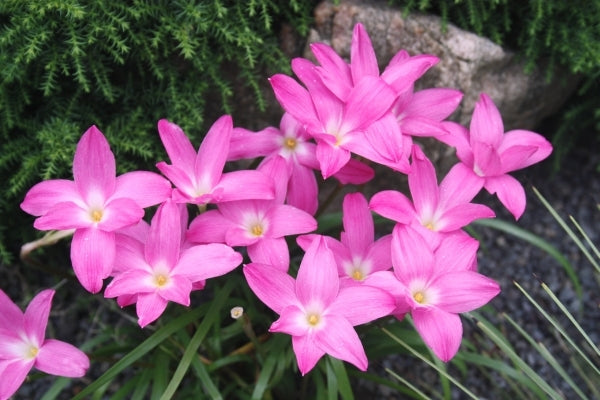Zephyranthes 'Heart Throb'
Heart Throb Rain Lily
Item #: 5945
Zones: 7b to 10b
Dormancy: Winter
Height: 6" tall
Origin: Mexico
Pot Size: 3.5" pot (24 fl. oz/0.7 L)
To be alerted when this plant is back in stock, log in and add it to your wishlist. You will receive an email when it is available.
It's hard to remember the emotions that ran through my mind when I first saw Zephyranthes 'Heart Throb' in flower, but my guess is, it must have resembled a hot flash. This Yucca Do introduction is a nocturnally-opening hybrid of Zephyranthes drummondii, from the famed 'Labuffarosea' strain. From midsummer through fall (after rains) 6" stalks emerge, atop which unfurl lovely, 2" unique, reddish-pink (that's hard to capture with the camera) flowers with a white eye. The flowers change from dark reddish pink to medium pink on day two, still highlighted by the contrasting white central eye zone. Zephyranthes 'Heart Throb' isn't fast to multiply, but we hope you'll agree it's worth the wait.
Maintenance:
Zephyranthes, the Rain Lilies, are very low maintenance where they are winter-hardy (generally zone 7 and warmer). The foliage can be removed when it has turned brown and that is about it. Often even this is not necessary. Rain lily cultivars that multiply rapidly, and many do, often push bulbs up out of the ground as they get crowded. These need to be reset so the bulbs are underground, and protected from freezing weather. When a rain lily gets to this stage it is a good time to dig the whole clump, divide into smaller clumps and replant them. This can be done most any time of the year.
Many Rain Lilies are very fertile and produce a good crop of seed after bloom. Not all Rain Lily cultivars come true-to-type from seed. In these cases either 1. remove seed pods before the seed matures and drops around the parent plants or 2. collect seed and sow elsewhere away from the parent plant.
Rain lilies are also very easy to grow from seed; usually germinating in a weeks time. If bulbs are grown continuously, which requires a sunny frost free location in the winter, they can bloom in a few years.
Rain lilies can be grown in pots where they are not winter hardy. Protect them from freezing over winter by either bringing them into a heated space and keeping them growing over winter, or allowing them to go dormant by drying them out and storing them in a cool but frost free location.
Growing Conditions:
A sunny location is best; more sun, more flowers. All will thrive in gardens of average moisture. None need the long hot dry spell that some species native to the southwest US and Mexico are subjected to in their native habitat. A few species, such as Zephyranthes candida from Argentina will thrive in a wet spot. All respond to rain with a huge flush of blooms. It often takes very little rain for them to bloom, often just the change in barometric pressure. No amount of irrigation will trigger the big flush of bloom, though some rain lilies will bloom intermittently and lightly between rains. Nearly all are winter hardy in zone 7 when planted in the ground. Bulbs should be planted underground with about 1" of soil on top of the bulbs.
Natural Impact:
Perhaps one would want the Zephyranthes to bloom continuously for months on end. Yet their nature to quickly produce a stunning display of bloom, where the day before there were none, adds a degree of drama that few other plants do. Gardens have been described as the slowest of the performing arts and the stunning display of Zephyranthes and their close cousin Habranthus demand that one go out into the garden and enjoy their performance. Broad masses of rain lilies make a dramatic display; either buy multiples or multiply the ones you have by division and/or seed.



-
Other Attributes
Genus: Zephyranthes
Flower Color: Pink
Leaf Color: Green
Bloom Time: Summer
Container Role: Fillers
Garden Themes: Cottage Garden Plants , Fairy Garden Plants , Gnome Gardens , Green Roofs , Rock Garden Plants , Southwest Garden Plants
Other: Drought Tolerant Plants , Fragrant Flowers , Pollinator Plants , Medicinal Plants , North American Native Plants , Ornamental Seed or Fruit , Rain Garden Plants , Xeriscaping Plants




